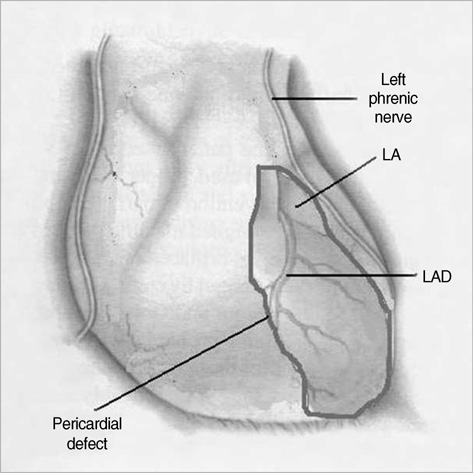J Korean Med Sci.
2010 Jan;25(1):145-147. 10.3346/jkms.2010.25.1.145.
Partial Pericardial Defect Incidentally Discovered During Coronary Bypass Surgery
- Affiliations
-
- 1Department of Thoracic and Cardiovascular Surgery, Korea University Medical School, Seoul, Korea. ksunmd@kumc.or.kr
- 2Department of Radiology, Korea University Medical School, Seoul, Korea.
- KMID: 1713846
- DOI: http://doi.org/10.3346/jkms.2010.25.1.145
Abstract
- A 71-yr-old male patient with three vessel coronary artery disease underwent a coronary artery bypass graft. The patient was found to have a large pericardial defect at the apex of the heart that measured approximately 18 cm in circumference. The edge of the pericardial defect impinged on the epicardial coronary arteries. The left phrenic nerve descended via the dorsal boundary of the pericardial defect. Following coronary artery bypass grafting, the pericardial defect was repaired with a polytetrafluorethylene patch. The patient had an uncomplicated postoperative course.
MeSH Terms
Figure
Reference
-
1. Nguyen DQ, Wilson RF, Bolman RM 3rd, Park SJ. Congenital pericardial defect and concomitant coronary artery disease. Ann Thorac Surg. 2001. 72:1371–1373.
Article2. Deutsch V, Yahini JH, Shem-Tov A, Neufeld HN. Congenital pericardial defect. Br J Radiol. 1970. 43:67–71.
Article3. Kaneko Y, Okabe H, Nagata N. Complete left pericardial defect with dual passage of the phrenic nerve: a challenge to the widely accepted embryogenic theory. Pediatr Cardiol. 1998. 19:414–417.
Article4. Lajos TZ, Bunnell IL, Colokathis BP, Schimert G. Coronary artery insufficiency secondary to congenital pericardial defect. Chest. 1970. 58:73–76.
Article5. Gassner I, Judmaier W, Fink C, Lener M, Waldenberger F, Scharfetter H, Hammerer I. Diagnosis of congenital pericardial defects, including a pathognomic sign for dangerous apical ventricular herniation, on magnetic resonance imaging. Br Heart J. 1995. 74:60–66.
Article6. Risher WH, Rees AP, Ochsner JL, McFadden PM. Thoracoscopic resection of pericardium for symptomatic congenital pericardial defect. Ann Thorac Surg. 1993. 56:1390–1391.
Article7. Gatzoulis MA, Munk MD, Merchant N, Van Arsdell GS, McCrindle BW, Webb GD. Isolated congenital absence of the pericardium: clinical presentation, diagnosis, and management. Ann Thorac Surg. 2000. 69:1209–1215.
Article8. Robin E, Ganguly SN, Fowler MS. Strangulation of the left atrial appendage through a congenital partial pericardial defect. Chest. 1975. 67:354–355.
Article9. Bernal JM, Lapiedra JO, Gonzalez I, Saez A, Pastor E, Miralles PJ. Angiocardiographic demonstration of a partial defect of the pericardium with herniation of the left atrium and ventricle. . J Cardiovasc Surg (Torino). 1986. 27:344–346.10. Finet G, Bozio A, Frieh JP, Cordier JF, Celard P. Herniation of the left atrial appendage through a congenital partial pericardial defect. Eur Heart J. 1991. 12:1148–1149.
Article
- Full Text Links
- Actions
-
Cited
- CITED
-
- Close
- Share
- Similar articles
-
- A Case of Partial Congenital Pericardial Defect Presenting as Acute Coronary Syndrome
- Congenital Partial Left Pericardial Defect
- Coronary Artery Fistula Associated with Atrial Septal Defect: Report of one case
- Anomalous right coronary artery from pulmonary artery discovered incidentally in an asymptomatic young infant
- A Case of Congenital Pericardial Defect



